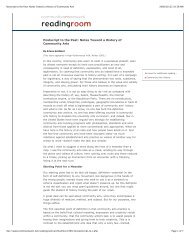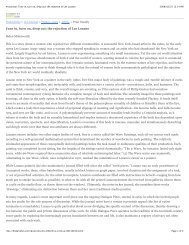The New Spirit of Capitalism - Dark Matter Archives
The New Spirit of Capitalism - Dark Matter Archives
The New Spirit of Capitalism - Dark Matter Archives
You also want an ePaper? Increase the reach of your titles
YUMPU automatically turns print PDFs into web optimized ePapers that Google loves.
12the economic process. Indeed, it is because <strong>of</strong> the existence <strong>of</strong> this constraint that the processis legitimised. We could even say that the price to pay, if people are to consider corporateactivities (and the organisational models they inspire) to be legitimate, is the implementation<strong>of</strong> testing systems that act as a constraint upon firms’ general management.We are going to take one example <strong>of</strong> the way in which the accumulation can beconstrained by references to that which is being required <strong>of</strong> a firm (expressed in terms <strong>of</strong> thecommon good, i.e., using the vocabulary <strong>of</strong> the present article, in terms <strong>of</strong> the justificatoryregime). In a Market Cité, the validity <strong>of</strong> pr<strong>of</strong>its (and <strong>of</strong> the societal order that results from theconfrontation between the many different people who are also seeking a pr<strong>of</strong>it) dependsentirely on whether the market test fully satisfies constraints such as the equality <strong>of</strong> chances -so that success can be fully attributed to merit alone (in the present example, to the ability toseize the opportunities that the market <strong>of</strong>fers, and/or to the attractiveness <strong>of</strong> the goods andservices on <strong>of</strong>fer) rather than to any pre-existing balance <strong>of</strong> power. Amongst these constraints,note first and foremost the assurance that any given situation will be a competitive one(marked by an absence <strong>of</strong> dominant positions, previous agreements, cartels), and thatinformation will be transparent. As such, it is only under certain extremely restrictiveconditions that a market test can be said to be legitimate. Moreover, the fulfilment <strong>of</strong> all <strong>of</strong>these conditions fails to provide, in and <strong>of</strong> itself, any specific contribution to the creation <strong>of</strong>pr<strong>of</strong>it. Quite the contrary – it can be a serious handicap.At a broader level, in a society where much testing is subjected to the same constraintsas those that feature in our definition <strong>of</strong> a “legitimate test”, the strength <strong>of</strong> society’s strongermembers is diminished. This is because the ways in which the tests are formulated (attemptsto make them “fairer”) tend to restrict opportunities for people who possess a diversified yetpoorly defined set <strong>of</strong> strengths – forces that tend to be displaced, confused, exchanged andextended for no other reason than the strategic necessities <strong>of</strong> a given situation. You cannotpay a literary critic so that s/he will recognise you as a great and inspired author; you do notbecome a chief <strong>of</strong> staff simply because you are the minister’s cousin, etc. Victory by anymeans is not possible.And yet, tests <strong>of</strong> strength and legitimate tests should not be construed as standaloneentities that exist in opposition to one another. <strong>The</strong>re is a continuum between the two, leadingto a situation in which tests are seen as being more or less fair. Moreover, we can always findout how it is that an action which stems from a test’s underlying strengths detracts from itsavowed legitimacy. One example is the way in which the handicap <strong>of</strong> a child’s socioeconomicsituation is recognised nowadays as something that affects scholastic performances – withoutexaminers having done anything explicit about it.Each <strong>of</strong> these two types <strong>of</strong> tests (the test <strong>of</strong> strength and the legitimate test)corresponds to a specific mode <strong>of</strong> action. We call the first a “mode <strong>of</strong> categorisation” becausean individual’s actions are publicly judged by other people. Here, the judgement is basedupon certain explicit and acknowledged principles <strong>of</strong> equivalency, many <strong>of</strong> which are legallyenforced. As a result, this mode refers to social conventions that are imbued with a broadbasedvalidity as well as with a certain type <strong>of</strong> externality (i.e., a form <strong>of</strong> transcendence).Consequently, such conventions can be envisaged independently <strong>of</strong> the situations in whichthey are acted out.<strong>The</strong> second we call a “displacement mode”. This is because the orientation <strong>of</strong> theactions and the forces which it infers change depending on local circumstances and/or the













